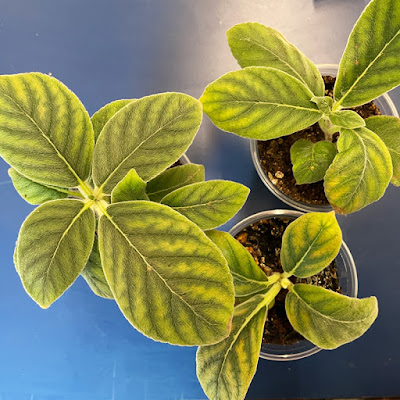Sinningia leucotricha is a species that has a normal, leafless dormancy phase. They can be grown without this, particularly when young, but it is normal for them, and I think can result in better blooming cycles. However, if you are not used to keeping houseplants that are strongly seasonal in their growth, or even plants that produce a minimum of new foliage each year, this might be alarming to you. So let's discuss.
The first thing I need you to do is not panic. :)
So what does it look like? First, the foliage starts looking tired. It can even start looking like there is a nitrogen deficiency, like these plants here.
 |
| Sinningia leucotricha seedlings with mature, aging foliage; semi dormant |
How do you differentiate between nitrogen deficiency and dormancy? Well, I don't have a perfect answer for this, but largely I would consider "stage" or "season". In older plants that have been trained to seasonal growth through warm, damp summers and cool, dry winters, obviously they start to visibly shut down their foliage in the fall. But if you are an apartment dweller, and the plant gets only small seasonal changes, it is going to decide on its own when its time to take a nap. Here, you need to consider how long has the foliage been on the plant. Has the foliage been in place a while, and suddenly started looking trashy? If so, dormancy is likely. This may eventually align with the seasons, particularly on a windowsill, since the seasonal changes in light intensity and window draftiness will give the plant some signals.
As a side comment, I don't find the species to be a particularly heavy feeder, so by that token, nitrogen deficiency is automatically unlikely. Of course, it is also never quite impossible. Just make sure you feed it "sometimes."
If you see your plant doing this, perhaps slack off on the watering a little, letting it dry out more or for a little longer between watering, but wouldn't withhold completely.
Eventually, the plant may just get over itself and pop out some new growth, like the wee leaves you see starting here:

|
| Sinningia leucotricha seedling with new apical growth |
In this case, just continue on with normal care like nothing happened.
But the plant may fully shut down the foliage like you see here:
 |
| Leafless-dormant Sinningia leucotricha seedlings |
It may even be crunchy-dry:
 |
| Crunchy Sinningia leucotricha foliage |
I repeat: please do not panic.
At this point, we will similate a "dry winter". Ideally this means cooler temperatures - I usually keep plants around 55F in an unheated basement, but work with what you have. I've also just set plants aside on a cool tile floor away from the heat. You'll also dramatically reduce water at this stage. You can still water *a little*, on occasion, but bias toward bottom watering to avoid getting the crown of the tuber wet. Be patient. Accept that the plant needs a nap. As long as that tuber looks plump and undamaged, all is fine.
If the foliage seems to come off easily, take it off. Don't force it though, you don't want to chance damaging the crown by ripping the little stem off.
Remember to check on it periodically, see how it looks, see if there is any change. What you are watching for is this:
 |
| Fuzzy new Sinningia leucotricha growth! |
Its wakingup! When you see this, you can put it back in high light if you've moved it off elsewhere while dormant, start increasing water, and maybe feed it at this stage. The plant is entering its spring/summer phase.
From here, you know pretty much what to expect. It will grow new foliage, sometimes one stalk, sometimes a few. It may flower soon, when the foliage is partially grown but not mature. During and after flowering the foliage will continue to expand until it reaches its full size for the season, at which point it will be a medium silver-green color. Then it turns to bulking up its tuber. The foliage may not change much, or at all from here to the end of the growing season, but the plant is busy doing important work below the soil surface to prepare for next winter.
You will likely find that each year, the foliage will increase in size or leaf count as the tuber increases in size. Enjoy watching the show each spring, knowing you've done a good job over the past year to help it prepare for the event.
For more photos and chit chat about this species in various stages of development, including a look at my oldest plant entering dormancy last fall and the beginnings of its show this spring, check out the instagram hashtag #pgcsinningialeucotricha.
